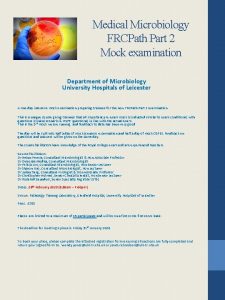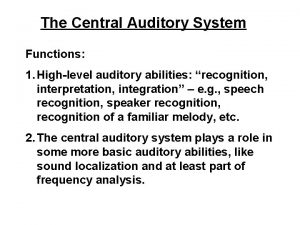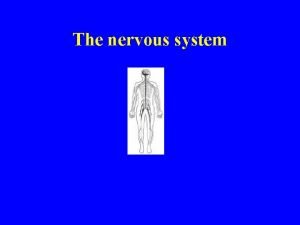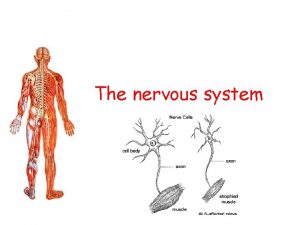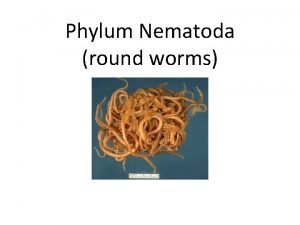Central nervous system Dr Heyam Awad FRCPATH 2017







































- Slides: 39

Central nervous system Dr Heyam Awad FRCPATH 2017

LECTURE 2: disturbed fluid balance and increased intracranial pressure Topics to be covered: - Increased intracranial pressure. - Brain edema - Hydrocephalus - Herniation - Cerebral ischemia

ILOs • Understand causes and symptoms of increased intracranial pressure. • Define cerebral edema and know its types and causes. • Define hydrocephalus and know its types and causes. • Define herniation and know its types and complications • Understand autoregulationo f blood flow in the brain • List causes of hypoxia and ischemia • Understand outcomes of global brain ischemia • Apply the above knowledge in clinical cases.

The cranium. . • The brain is enclosed within the skull, which is a rigid box that protects it. • In adults, skull bones cannot expand • So if the material within the cranium increases. . Pressure will increase= increased intracranial pressure

What's inside the cranium? • ROUGHLY: 80% brain tissue ( including fluid; around 75%) : 10% blood : 10% CSF (cerebrospinal fluid) IF any of these components increases, the intracranial pressure increases.

OK, so what is intracranial pressure (ICP)? ? ? • It is the pressure inside the skull and is measured in millimeters of mercury • at rest, it is normally 7– 15 mm. Hg for a supine adult. • The upper limit of ICP is 20– 25 mm Hg • If pressure in the cranium is higher than this upper limit= increased intracranial pressure (= intracranial hypertension.

Causes of increased intracranial pressure • mass effect : brain tumor, hematoma, or abscess. • generalized brain swelling : ischemic-anoxia states, hypertension • increase in venous pressure : heart failure • obstruction to CSF flow and/or absorption or increased CSF production: hydrocephalus. • Idiopathic or unknown


clinical presentation according to severity:

Brain edema= cerebral edema • = accumulation of excess fluid within the brain parenchyma. • Two types: vasogenic and cytotoxic edema. . Usually coexist

Vasogenic edema • Due to disruption of blood brain barrier. • So: shift of fluids from vessels to brain tissue. • Lymphatic vessels are rare in the brain. . So there is little or no resorption of excess edema fluid. • Can be generalised ( due to hypoxia) or localised ( due to inflammation or tumors)

Cytotoxic edema • Due to neuronal or glial cell membrane injury. • Causes: toxins or hypoxia. • Here fluid moves from cells to interstitial tissue.

morphology • With edema, the brain becomes swollen. . And its weight increases. • The normal adult human brain weighs on average about 1. 2– 1. 4 kg , or about 2% of total body weight, although there is substantial individual variation. • Edema causes flat gyri and narrow sulci

Brain edema

hydrocephalus • Increased CSF within ventricles. • Caused by overproduction or decreased resorption of CSF. • Overproduction: rare, due to choroid plexus tumors. • Decreased resorption. . Can be localised or generalised.

hydrocephalus • Localised: noncommunicating hydrocephalus. • Generalised: communicating hydrocephalus.

• In infancy, before closure of the cranial sutures , the head enlarges. • After closure of the cranial sutures: increased intracranial pressure occurs. Of course there is no increase in head circumference

hydrocephalus

hydrocephalus

herniation • Increased volume of tissue inside the skull. . Increased intracranial pressure which causes focal expansion of the brain tissue. • Because the cranial vault is subdivided by rigid dural folds (falx and tentorium)…. The expanded brain tissue is displaced in relation to these folds. • Expansion: herniation

herniation • Subfalcine = cingulate • Transtentorial = uncinate • Tonsillar.

herniation

Cingulate herniation -cingulate gyrus displaced under edge of falx -Can cause compression of anterior cerebral artery

Transtentorial herniation • Medial aspect of temporal lobe compressed against the free margin of the tentorium. • Third cranial nerve compressed. . Dilated pupil, impaired ocular movement on the side of the lesion • Posterior cerebral artery can be affected. . Ischemic injury to tissues supplied by it including visual cortex.

Tonsillar herniation • Displaced cerebellar tonsils through foramen magnum • Brain stem compression… respiratory and cardiac centres in medulla compromised. • LIFE THREATENING

Hypoxia and ischemia • Brain is highly oxygen dependent. • Brain 2% of body weight but receives 15% of cardiac output • 20% of total body oxygen consumption. • Autoregulation of vascular resistance allows stability of cerebral blood flow over a wide range of blood pressures and intracranial pressure. • If blood pressure very low (systolic less than 50)… hypoxia



Brain hypoxia • Functional hypoxia. • ischemic hypoxia

Functional hypoxia • Low partial pressure of oxygen: high altitude • Impaired oxygen carrying capacity: anaemia and CO poisoning • Decreased oxygen use by tissues: cyanide poisoning

Functional hypoxia

Ischemic hypoxia • Hypo-perfusion due to hypotension or vascular obstruction • Ischemia can be global or focal • Focal ischemia causes infarctions and this will be discussed in the next lecture.

Global cerebral ischemia Occurs due to severe hypotension, systolic below 50 mm Hg: • Cardiac arrest • Shock • Severe hypotension • Outcome depends on severity and duration of insult

Global ischemia • Neurons more susceptible to hypoxic injury than glial cells. • Most susceptible neurons: pyramidal cells of hippocampus and neocortex + Purkinje cells of the cerebellum

ischemia • If mild: transient confessional state • severe : neural death, if survive: severely impaired neurologically • Severest forms result in brain death.

Morphology of reversible global ischemia • Swelling • Wide gyri • Narrow sulci • Poor grey white matter demarcation

Irreversible global ischemia can cause brain death • Diffuse cortical injury with flat EEG ( isoelectric EEG) • Brain stem damage: No reflexes and no respiration • If on mechanical support: autolysis of brain= respirator brain /

Suggested reading about brain death…for those who are interested • https: //www. ncbi. nlm. nih. gov/pmc/articles/PMC 2772257/ • Also a pdf is downloaded in my webpage…. This is an interesting read I encourage you to have a look!!

 Awad mataria
Awad mataria Khaled awad md
Khaled awad md Exemplum rhetorical device
Exemplum rhetorical device Neuron process
Neuron process Sensory input and motor output
Sensory input and motor output Processes of a neuron
Processes of a neuron Frcpath part 1 microbiology
Frcpath part 1 microbiology Frcpath chemical pathology
Frcpath chemical pathology Mydetas
Mydetas Nervous system major divisions
Nervous system major divisions Central nervous system amusement park
Central nervous system amusement park Cerebellum central nervous system
Cerebellum central nervous system Nervous tissue
Nervous tissue Hydra neurons
Hydra neurons Central auditory nervous system
Central auditory nervous system Electrical synapse vs chemical synapse
Electrical synapse vs chemical synapse Central nervous system for kids
Central nervous system for kids Nervous system and digestive system
Nervous system and digestive system Endocrine system vs nervous system
Endocrine system vs nervous system Nervous system vs endocrine system venn diagram
Nervous system vs endocrine system venn diagram Adh function
Adh function Central nervous sysytem
Central nervous sysytem Chemical messengers of the nervous system
Chemical messengers of the nervous system Platyhelminthes classification
Platyhelminthes classification The nervous system is made up of
The nervous system is made up of Neuron anatomy
Neuron anatomy Learning objectives of nervous system
Learning objectives of nervous system Componentes componentes
Componentes componentes Stimulus in nervous system
Stimulus in nervous system Nervous system objectives
Nervous system objectives Autonomic nervous system visceral
Autonomic nervous system visceral Parasympathetic
Parasympathetic Plexuses
Plexuses Sns pg
Sns pg The nervous system brain scienstructable
The nervous system brain scienstructable Somatic vs autonomic nervous system
Somatic vs autonomic nervous system Nematoda
Nematoda Arthropoda insecta
Arthropoda insecta Arthropods structure
Arthropods structure Nervous system of arthropods
Nervous system of arthropods






